When I heard there was a part of Tokyo called the “Harajuku for Grandma’s,” I knew I HAD to check it out! Coming to Sugamo, instead of rows of kawaii-looking youths, you’ll find hordes of grannies pulling their uniquely patterned wheeled shopping bags. Instead of pastel walls and the latest food crazes, you’ll find ancient traditional cusine, historic restaurants and fashions long forgotten. One of the reasons this area is such a draw to the older population is that the street has a very nostalgic feel. The shops and atmosphere recall a beyond time, from the Shōwa era. The Shōwa era refers to the reign of Emperor Shōwa from 1926 until 1989. Shops here sell everything from tea, pottery, traditional sweets and pastries, kimonos, kitchen implements as well as pharmacies and medical assistance devices. Everything an Obachan (grandmother) needs to get by!
When to Visit
This area is much quieter than other parts of Tokyo so it’s a wonderful place to visit if you want to get away from the hustle and bustle. The best days to visit are on the 4th, 14th or 24th of the month. During these days is when you’ll find the street market, which brings a super lively and busy atmosphere to the entire street. Plus there are lots more street food items to discover.
Access
Sugamo Station is the best spot to arrive for our little street tour. Sugamo Station gives access to the Mita and the Yamamoto metro lines. From Tokyo Station, it takes about 20 minutes to arrive in Sugamo on the Yamamoto line. The one-way ticket costs 170 yen.
History
Sugamo’s popularity isn’t a new phenomenon. It has been one of the most underrated and yet favourite spots for hundreds of years. In the Edo period, you would get hundreds of pilgrims on their way to Sugamo to visit the old Edo Rokujizo Shinshoji, a stone temple and great pagoda. This was because Jizo-dori was part of the Nakasendo, the route that connected Kyoto to Edo. Jizo-dori was one of the five significant roads that spread out to important hubs throughout Japan. This route was used by both pilgrims as well as merchants on their way to Kyoto. To accommodate all these pilgrims, shops and restaurants began popping up to serve these new customers on the “highway.”
A colossal bronze statue of the Jizo was placed on the road to mark its importance. Jizo is a Japanese name for a person who has attained enlightenment but postpones Nirvana to help others to attain enlightenment. Today you can see that the bronze statue outside the Shinshoji Temple. This Jizo is one of five that were initially placed at the starting points of the Nakasendo roads as protection. Later in 1891, the famous Togenuki Jizo Kogan-ji temple was moved from Ueno to Sugamo, bringing even more visitors.
Sugamon, Sugamo’s Mascot
Sugamo is so popular the neighbourhood even has its own mascot! His name is Sugamon, which means “duck’s nest.” You can spot Sugamon all over the street, from large-scale models to banners and more. Near the gates to Jizo-dori, you can find a big fluffy ball that visitors are actually encouraged to pat as this is meant to represent Sugamon’s behind. It’s a legend that if you pat his bottom, you will get married! Or if you pat him gently, you will live a long and comfortable life as you grow old. It can’t hurt to try!
Sennari Monaka
Before arriving at the famous pedestrian shopping street, you MUST make your first stop at Sennari Monaka. This shop serves up freshly make dorayaki every morning. Dorayaki is the PERFECT breakfast food. Dorayaki are tiny pancakes sandwiched in between these huge slices of butter and azuki bean paste. The staff working here can be seen behind the glass window in the front and flipping the freshly made pancakes. You can eat your goodies at a small counter inside. To give your pancakes a really unique taste, shake a bit of salt and pepper on top. Sound weird, I know, but it really brings out something special and balances out the sweetness of the bean paste! The butter and azuki pancake costs 210 yen. Although you can get these all the time in konbinis, there is NOTHING that compares to the taste of a freshly made one.
Another popular sweet treat sold here is Monaka. Monaka is made from two thin, crispy wafers made of mochi and sandwiched between various filling. This monaka is in the shape of a hyōtan (gourd), a symbol of good fortune. A great samurai once tied a gourd onto his flag each time he won a battle, so the gourd became synonymous with victory. These monaka come in all different flavours like red bean, white bean, black sesame and plum. You can buy these individually for 100 yen or a package of 20 for 2,376 yen. Great to bring home for friends!
Motoko Warabimochi
Before the central area, walk down this tiny side street until you see the wooden market stand that sits outside right on the road. This shop sells Warabimochi. Warabimochi is different from the traditional mochi as it is made from warabiko, a starchy plant, instead of glutinous rice. This produces a more malleable and translucent texture. The most popular versions of Warabimochi are covered in kinako (roasted soybean powder). The mochi is served cold and therefore is a popular summertime treat. The brown sugar mochi here is so delicious and my favourite! Super unique flavour not found in many other places. A tray of the mochi costs 540 yen but readily serves a group of people.
Shinshōji Temple
Just across the street from the mochi stand is Shinshōji Temple. Once you walk through the gate, you’ll immediately see the giant Jizo statue beside the stairs to the temple. This is that bronze Jizo we spoke of before that is one of Edo’s six highways guardians. These Jizo were meant to give protection to travellers on the roads. The Jizo sits crossed-legged on a giant lotus leaf. When you see a Buddha sitting on a lotus leaf, this symbolizes the one who overcame pains and became enlightened. This is just as the Lotus flower grows in dirty, muddy waters but blooms into a perfect flower. He holds a large staff and wears an umbrella-shaped hat in his head. In his head and in his left hand, he has a lotus blossom, the symbol of enlightenment.
Raijindo
At the entrance to Old Nakasendo, we find Raijindo. Although there are 35 other stores throughout Tokyo, this is their central location. Raijindo is one of the best places to try senbei. Senbei is simply a rice cracker and one of the most historic Japanese foods, coming to Japan around 538 AD. This shop has been open for 33 years, and their rice crackers are genuinely unique. The owner wanted to create an upscale version of the usually very cheap treat. He made sure to use only the highest quality ingredients, and his crackers were going to be HUGE in size.
One of the best flavours to try here is their multi-dipped crackers. These are dipped a multitude of times into soya sauce and then fire-grilled. Each time the cracker is dipped it builds up a thick layer and creates a deeper umami taste. You can also try their burnt crackers; these are great if you really love that smoky flavour. These crackers cost from 100 yen to 200 yen apiece (the more they are dipped, the more they cost.)
Mizuno
One of the famous treats to get in this area of Tokyo is the Shio Daifuku at Mizuno. Shio means salt, so this dessert literally translates into Salted Daifuku. I adore salty-sweet treats, so I found this pillow-soft mochi filled with sweet bean paste to be perfectly complemented by the salt. The shop opened in 1937, and they certainly have perfected the craft over those years. Drink it along with a cup of green tea for a refreshing combo.
Jizo Soba Ohashiya
Jizo Soba Ohashiya was established in 1918, making it over a hundred years old! Ever since the store’s opening, the shop has been run by the same family, passing from one generation to another. This way, they have ensured the recipes used to create this handmade soba have remained the same over time. They use a very particular blend of three types of bonito flakes to make their iconic dashi stock. The soba is made from high-quality buckwheat and the taste blends utterly perfectly with the dashi sauce.
One of the cutest parts of the shop front is the painting of Sugamon carrying a tall stack of soba noodles. But he has lost his balance and is in the process of dropping them to the ground. You can pose right in front of this image to look like the soba noodles are a moment away from falling on your own head! Another great place for a classic Sugamo photo op.
Sugamo Jizodori Gates
Many gates mark Jizo-dori but the first one you’ll find is a little way down the street. I adore the beautiful designs of these gates with the brightly coloured letters and gorgeous yellow fan on top. Sugamo Jizo-dori Shopping Street is 780 meters long with over 200 stores to peek into on either side. You’ll notice at the street is extremely smooth, without any raised sidewalks. This is to allow any of those in wheelchairs or assistive devices to get around more easily.
Kintaro Sugamo Candy Store
With its frilly pink packages on the side of the street, this delightful candy store simply invites you inside. The Kintaroame candy store has been serving customers here for over 60 years! Inside, they sell traditional sweets in more than 50 different flavours. Everything from blueberry to coffee, soybean and sakura!
Kintaro is the name of a boy from a famous Japanese fairy tale. Kintaro wrestled with a bear and lived to tell about it. Now his image is embedded in some of the most popular candies in the store, along with the bear too! Making candy with these tiny images on them is a complicated technique to achieve and requires true artistry.
Matsumiya’s Spice
In a small wooden hut on the street, stop in and grab a sachet of shichimi spices at Matsumiya’s Spice stand. Shichi-mi tōgarashi, also known as seven-flavour chilli pepper, is a typical Japanese spice. You can actually see each one of the seven different flavours at this shop as they are mixed together for you. The herbs include; ground red chilli peppers, sanshō (“Japanese peppers”), roasted orange peel, black sesame seeds, white sesame seeds, hemp seeds, ground ginger, nori (seaweed) and poppy seeds. Since the ingredients aren’t pre-mixed, you can request more of any one flavour to customize the mixture to your liking. A small container of the shichimi costs only 300 yen, making a beautiful souvenir or gift.
Koganji Temple
Enshrined inside Koganji Temple is the image of the Togenuki Jizo (Buddha). The name Togenuki Jizo literally means “splinter-removing Buddha.” The name came from an old legend, which states that an old woman swallowed a needle and to protect herself, she then ate an image of the Jizo. Miraculously the needle came out without harming her. Today, you can still buy pieces of paper with the image of the Jizo on it. This picture is said to remove “thorns” from the mind and the body. These “thorns” can refer to anything hurting your body, from anxiety to body aches and even depression. You can even buy a set of five small images at the temple that you can stick on your body in the hopes of curing those ailments—a set of 5 costs 100 yen.
You’ll notice that there are miniature towels for sale at the shrine as well. And walking close to the Buddha, you’ll see lots of older women scrubbing and washing the Buddha. This ritual is called Arai Kannon. This is a means of prayer and the person doing the washing will be praying for relief in areas where they find pain. If you want, buy yourself a towel and scrub any parts of the Buddha where you want a bit of pain pulled out of your body.
Shiawase Dango
Shiawase Dango is a tiny stall beside the temple that sells a simple yet delicious treat. These grilled dango (soft rice balls) are coated in soya sauce and then grilled over a fire. This gives them the most lovely roasted flavour, which tastes so complex despite being so straightforward. They are known as “happiness dango.”
Atelier Sekka
Across from the temple, down a peaceful side street, is the Atelier Sekka. Atelier Sekka Yukika specializes in Kakigori. Kakigori is a wonderful Japanese dessert that consists of shaved ice covered in rich syrups. The shop’s claim to fame is their new syrups they serve up every day and their iconically fluffy shaved ice. If you visit in the Spring, you MUST try their Sakura kakigori, part cherry milk, part strawberry syrup with some freshly made strawberry compote hidden inside.
Somei Cemetery
Taking a slight detour from the main street, head up the road towards the Somei Cemetery. This cemetery is extra special during cherry blossom season when the cemetery becomes awash with pink and white petals. Inside the cemetery, you can spot famous graves that include members of the Mito Tokugawa clan and sculptor Takamura Kôun. Japanese cemeteries are so beautiful, and always filled with tree lined pathways and beautiful flowers. At each grave you might spot some items left behind. These are for the souls of the dead and are usually items they loved in life, like books, beer and even bowls of ramen. This is a gesture to show the dead that the living haven’t forgotten about them.
Konaya
This restaurant is the perfect place to stop if you’re looking for a filling lunch. Konaya specializes in curry udon noodles. The rich beef stock is stewed for two whole days for it to reach its optimal flavour. The noodles are thick and cut by hand. But it is the addition of the curry flavour that really sets this dish apart! The curry udon is 1,130 yen, but you can add fried tempura shrimp and rice cakes if you’re extra hungry. I’m obsessed with Japanese curry and ramen so this felt like a marriage of the two incredible dishes!
Maruji Red Pants Pavilion
Back on Jizo-Dori, walk down a little bit until you see the iconic red awning of the Maruji Red Pants Pavilion. Maruji, or the “Red Pants Pavilion,” is one of the most popular shops on the street. The store is famous for selling their bright red underwear! This store is actually the 4th location in Tokyo. Outside, there is a giant sign in Kanji that reads, “Japan’s best red underwear.” Red is a symbol of vitality and happiness, so it has become very popular with the elderly to ensure they live a long and happy life! Since the shop has become somewhat of an attraction, it began to sell other items like t-shirts, socks and other unique souvenirs that everyone can enjoy. But if you want their classic good luck charm, pick yourself up a pair of red underpants!
Fight Gyoza
Walk along Jizo-dori until you reach a small side street marked on the map. Walking up the road, towards the end, you’ll find the bright orange awning with the name “Fight Gyoza” written in Kanji. This shop sells the fluffiest dumplings you’ve ever had! They aren’t made like traditional dumplings and have a completely different shape. The dumplings are quickly boiled, then deep-fried in hot oil. Creating this hardened exterior with this super fluffy filling. You can get 8 gyoza with rice and miso soup for 760 yen. Be sure to add some of their house pickles onto your place as they pickle really helph cut through the greasyness of the dumplings.⠀
Sugamo Post Office
Although a Post Office might seem pretty ubiquitous, the reason to stop outside this one is to see the adorable mailbox with the Sugamo mascot on top! The little duckie has his arms outstretched, awaiting your mail. An excellent place for a Sugamon photo op!
Sarutahiko Kōshindō
Tucked away, one the corner of the street, are the gates to the Sarutahiko Kōshindō shrine. The current shrine dates back to 1657! The Sarutahiko Kōshindō shrine is very famous for the stone monkeys that guard the temple. One giant monkey sits above three smaller ones in the positions of “see no evil, hear to no evil, speak no evil.” These monkeys are frequently seen wearing red jackets. These red jackets are thought to defend against evil.
Kōshinzuka Station
As you head off to end your day in Sugamo, you should make a stop at Kōshinzuka Station. This romantic, old-fashioned outdoor station feels like it is from a bygone time. This station feels like the culmination of everything that Sugamo is all about. Nostalgia and a look back at the Tokyo of years past.
I hope you loved this tour of Sugamo and found that the street is for much more than just Grannies. It’s a beautiful place to find some excellent nostalgic cusine and the perfect place to get away from the big city’s hustle and bustle.
Happy Travels, Adventurers

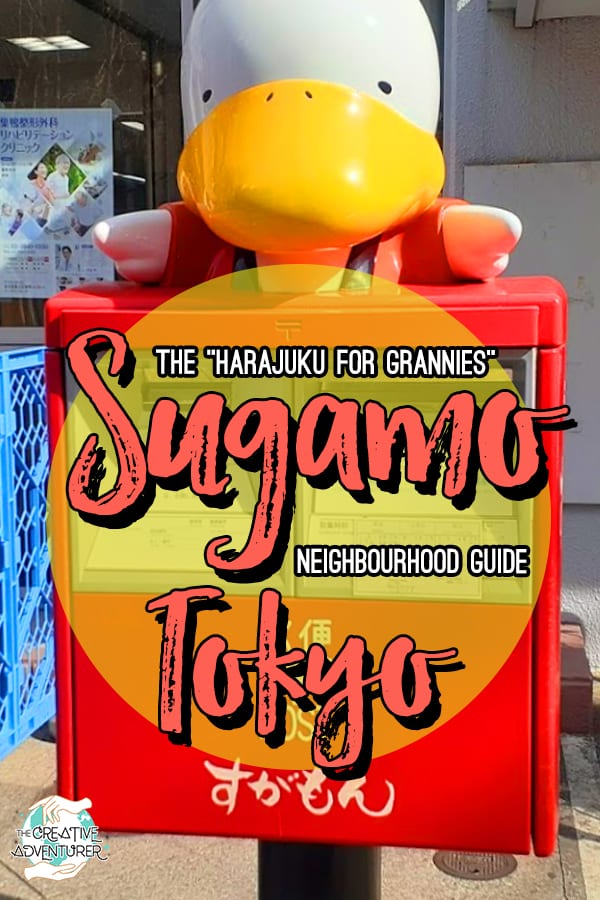
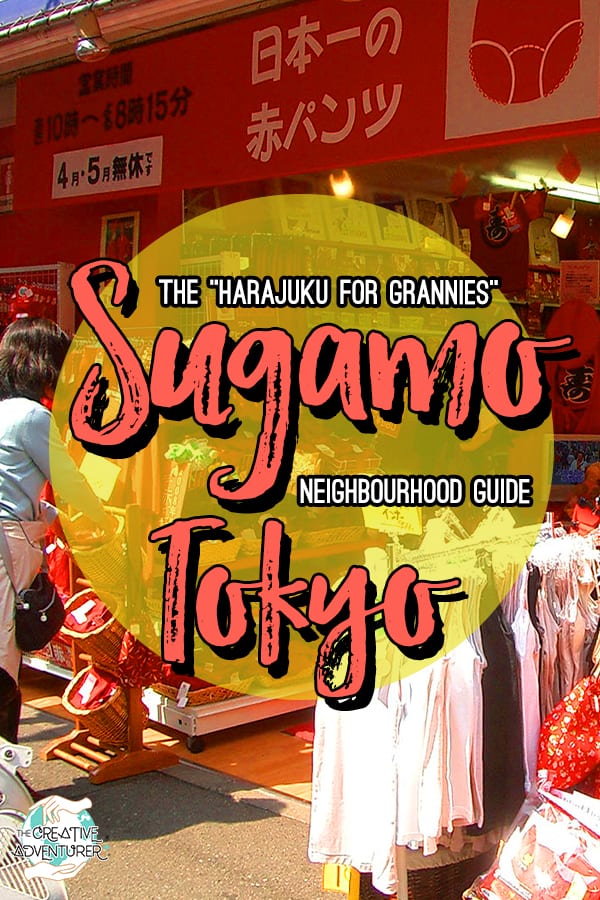
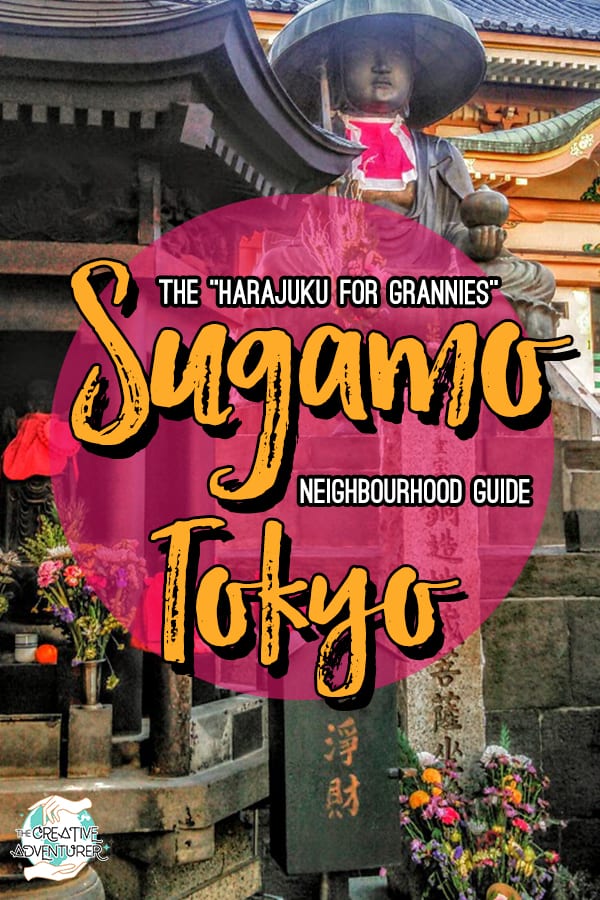

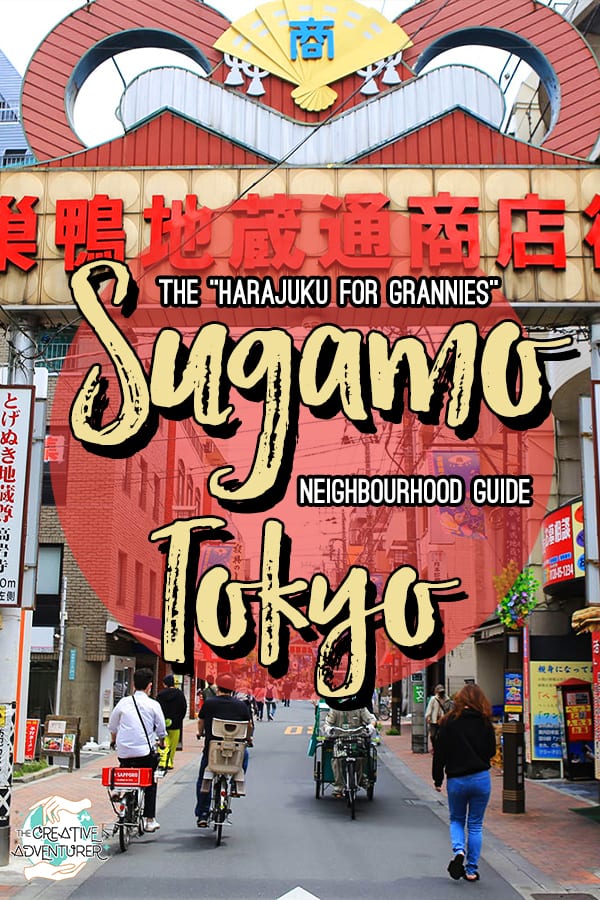


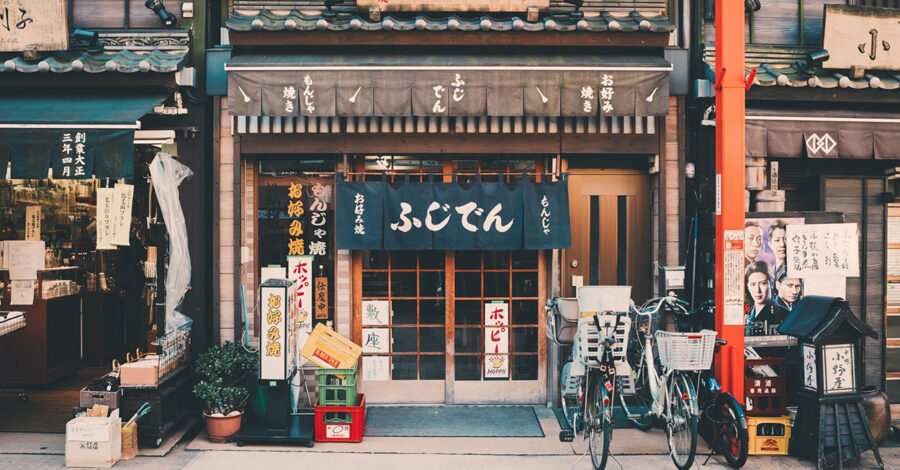

Leave a Comment